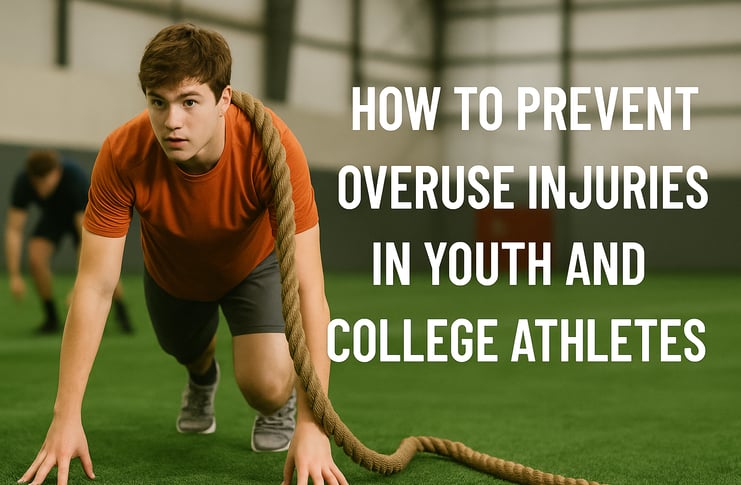How to Prevent Overuse Injuries in Youth & College Athletes: Smart Recovery Tips
Discover practical ways to prevent overuse injuries in youth and college athletes. Learn how to manage training loads, implement rest periods, screen movement, and catch red flags early—plus top Amazon recovery tools to support long-term performance.
5/22/20254 min read


How to Prevent Overuse Injuries in Youth and College Athletes
Smart strategies for parents, coaches, and athletes who want long, healthy careers.
Youth and college athletes are pushing harder than ever—more games, more practices, more pressure. And while drive is great, the downside is a growing number of overuse injuries. These aren’t the result of one bad fall—they build up over time from repetitive stress with not enough rest.
If you’re a parent or coach trying to keep your athlete in the game long-term, it’s crucial to manage training wisely, prioritize recovery, and watch for warning signs. This blog breaks it all down—and includes three recovery tools from Amazon that can help reduce the risk of injury without breaking the bank.
1. Manage the Training Load
Overuse injuries often start when athletes are doing too much, too fast. If they suddenly jump from three practices a week to six, their muscles, joints, and tendons don’t get enough time to adapt.
That’s why gradual increases are key. Experts recommend using a rough 10% rule—don’t increase intensity or volume more than 10% per week. And if your athlete plays one sport all year round? It might be time to rethink that. Kids who specialize in a single sport early are more likely to burn out and suffer overuse injuries.
Rotating sports, or even just taking some off-season time for general strength and mobility work, can go a long way toward keeping their body balanced.
2. Prioritize Rest—It’s Not Optional
Let’s be clear: rest is part of training. Young athletes need at least one full day off per week and should take a few weeks off throughout the year from their primary sport.
But rest doesn’t always mean laying around. Active recovery—things like swimming, walking, yoga, or low-impact strength training—gives overused joints and tissues time to bounce back while still building overall athleticism.
Product We Recommend:
UFlex Athletics Knee Compression Sleeve
[Available on Amazon]
This sleeve adds light compression and support without restricting movement. It’s great for athletes dealing with early signs of knee stress—especially those in sports with lots of cutting or jumping like basketball, soccer, or volleyball.
Why we like it: It stays in place, offers real support, and fits easily under gear.
3. Start Screening for Movement Imbalances
Before injuries show up as pain, they usually start as movement issues—tight hips, poor ankle mobility, weak core control. A simple movement screen every few months can help you catch problems before they turn into injuries.
One popular option is the Functional Movement Screen (FMS), which checks for mobility, strength, and symmetry in basic patterns like squats and lunges. A physical therapist, athletic trainer, or well-educated coach can guide athletes through these and recommend corrective work when needed.
Even simple flexibility or balance drills during warmups can reveal a lot. Keep an eye on movement quality, not just performance.
4. Recovery Tools Are Worth the Investment
After practices, especially tough ones, it’s important to give your body help bouncing back. Cold therapy and compression can make a huge difference in managing soreness and inflammation—especially for younger athletes whose joints are still developing.
Product We Recommend:
Pro Ice Youth Shoulder & Elbow Ice Wrap
[Available on Amazon]
This is a smart option for baseball players, swimmers, and tennis athletes. It’s made for younger athletes, fits comfortably, and holds the ice exactly where it needs to go.
Why we like it: Helps relieve joint stress after repeated throwing or swinging without using messy bags of ice.
5. Know the Red Flags (and Don’t Ignore Them)
Pain is never something to “push through”—especially for younger athletes. Here are some signs that might mean it’s time to scale back or get a professional evaluation:
Lingering soreness that lasts more than a few days
Pain that gets worse during activity
Sudden drop in performance despite regular training
Loss of interest or motivation (burnout is real)
Teaching your athlete to speak up early—before something becomes a serious injury—is just as important as building strength.
6. Support the Whole Body, Not Just the Injured Part
Injury prevention isn’t about one muscle or one joint—it’s about how everything works together. A weak core can lead to shoulder problems. Tight ankles can mess up knee mechanics. That’s why cross-training and full-body strength matter, especially during the off-season.
Wrist and hand overuse injuries are often overlooked in sports like gymnastics, tennis, or weightlifting. A little support during high-load activity can make a big difference in preventing strain.
Product We Recommend:
Neo-G Active Wrist Support
[Available on Amazon]
A lightweight brace that’s breathable, adjustable, and ideal for repetitive wrist movements. It’s perfect for gymnasts, pitchers, or even kids who lift or use battle ropes.
Why we like it: It doesn’t restrict movement but offers enough support to prevent overuse soreness from turning into something worse.
Final Thoughts
Overuse injuries in youth and college athletes aren’t just bad luck—they’re often the result of training choices that don’t allow enough recovery. But the good news is: they’re largely preventable.
Stick to these principles:
Manage workloads carefully
Make recovery a priority, not an afterthought
Use movement screening to stay ahead of issues
Watch for warning signs and listen to your athlete
Use smart gear to support recovery and performance
Athletes shouldn’t have to sacrifice their long-term health just to compete today. The goal is to build strong, resilient bodies that last—not just for the season, but for a lifetime.
FITNESS
Nutrition
WellnesS
info@movebetterco.com
© 2025. All rights reserved | Privacy Policy | Terms & Conditions